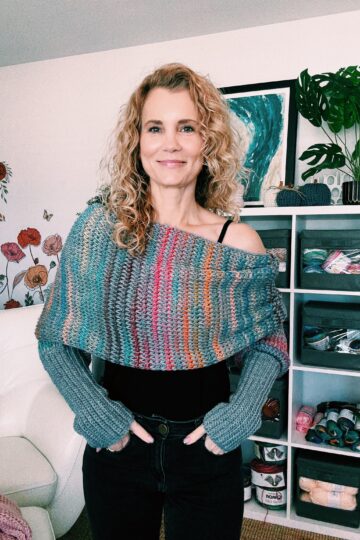Step into the world of crochet and discover how to make a Tunisian crochet knit stitch blanket. You'll learn the Tunisian crochet basics and turn simple stitches into a warm, stylish blanket.
Soon, you'll be snuggled up in your own handmade blanket!
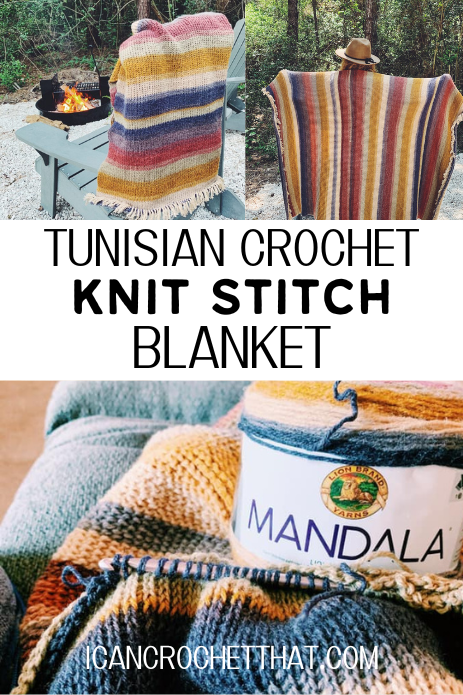
You can purchase a printable PDF of this pattern on our ICCT shop here or Etsy here.
This guide will walk you through making a Tunisian crochet blanket using the knit stitch. You'll start with the Tunisian knit stitch basics and add your own special touches.
It's perfect for both experienced crocheters and beginners. Mastering this technique will enhance your crochet experience and bring you hours (and hours) or enjoyment.
Let's start our journey into the world of Tunisian crochet. Your creativity and skill will combine to make a unique, cozy blanket. This blanket will be a treasure you'll love for many years.
I've gifted so many of these to friends and family and they all use and love this blanket!
The Basics of Tunisian Crochet
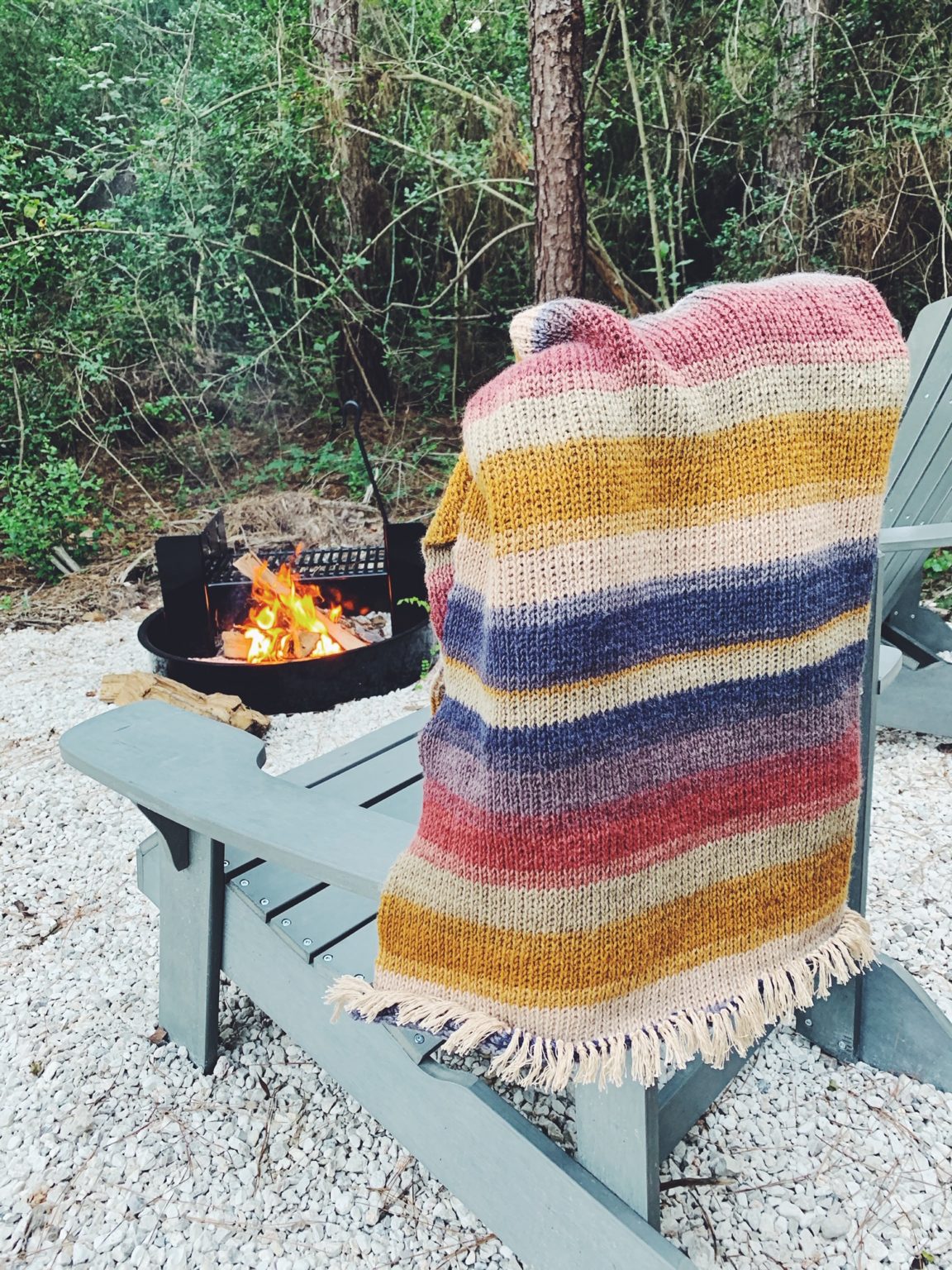
Are you ready to start your Tunisian crochet journey?
Let's dive into the basics of Tunisian crochet. This technique is different from traditional crochet and gives your projects a unique look and feel.
Understanding Tunisian Crochet
Tunisian Crochet blends knitting and crochet. Unlike regular crochet, you keep all loops on your hook, making the fabric thicker and more structured.
It creates a soft, dense, and warm fabric. It's ideal for cozy blankets, scarves, and winter accessories. Plus, it's just fun!
Here's a video in which I share all the basics you need to know about crocheting a blanket using the Tunisian crochet method.
Required Materials and Tools
Recommended Supply List
What to Buy to Get Started with Tunisian Crochet
To start with Tunisian knit stitch crochet, you'll need some key materials and tools. A Tunisian crochet hook with a long cord is essential.
You might also use stitch markers, tapestry needle, scissors, blocking mats and/or a steamer.
Choose a medium-weight yarn that's soft and suits the stitch's texture. Acrylic, wool, or a cotton-blend work well.
One of my favorites is Lion Brand's Mandala yarn. If self-striping, which not only creates a beautiful blanket, but with the color changes, it helps you not to get bored with doing the same stitch over and over again.
I purchase this yarn on LionBrand.com, Amazon.com and in my local Joanns store.
With a good grasp of the Tunisian knit stitch and the needed materials, you're set for your first project.
Why would you need a steamer and/or blocking mats for Tunisian crochet? Good question!
The answer: Tunisian crochet curls like crazy. At least most of the time. I've been on a mission to find gorgeous Tunisian crochet stitches that don't curl and this stitch is my favorite so far. There's no curling whatsoever, and it's just beautiful!
But the Tunisian crochet knit stitch curls a lot, so you'll need some basic knowledge of how to fix that. The talented Toni from TL Yarn Crafts has a fantastic video all about curling and what to do.
More Helpful Information About Tunisian Crochet
Recommended Reading
Articles on I Can Crochet That for Help with Tunisian Crochet
Step-by-Step Guide to Tunisian Knit Stitch
Now that you know the basics of Tunisian crochet, it's time to practice.
We'll guide you through creating the foundation row and the Tunisian knit stitch pattern. With clear instructions, you'll quickly master this versatile crochet technique.
Here's our video tutorial.
Working the Foundation Row
Start by chaining the needed stitches for your project, and learn how to do the forward pass and return pass. This is very important for Tunisian crochet.
Make sure your stitches are even and consistent for a beautiful fabric.
For the Tunisian knit stitch, you can chain any number of chains.
Establishing the Pattern
After the foundation row, you can start the Tunisian knit stitch pattern. This stitch is loved for its unique texture and versatility. Follow the steps below or in the video to master the Tunisian knit stitch and use it in your projects.
Practice and patience are key with the Tunisian knit stitch. Don't worry if your first tries don't look perfect. With time and effort, you'll get the hang of it.
Soon, you'll be creating beautiful crochet knit stitches that will wow everyone. I promise!
Tunisian Crochet Knit Stitch Written Instructions:
Foundation Row:
- Start with a foundation chain.
- Insert your hook into the second chain from the hook, yarn over, and pull up a loop.
- Repeat across the chain, leaving all loops on the hook.
Forward Pass:
- Skip the first vertical bar.
- Insert your hook from front to back between the front and back vertical bars of the next stitch.
- Yarn over and pull up a loop.
- Repeat across the row, leaving all loops on the hook.
Return Pass:
- Yarn over and pull through one loop (chain 1).
- Yarn over and pull through two loops all the way across.
Repeat Steps 2 and 3:
- Continue with the forward pass and return pass until your project reaches the desired length.
Binding Off:
- To finish, bind off by inserting the hook as for the knit stitch, yarn over, and pull through both loops on the hook.
- Repeat across the row.
Tunisian Knit Stitch for Beginners
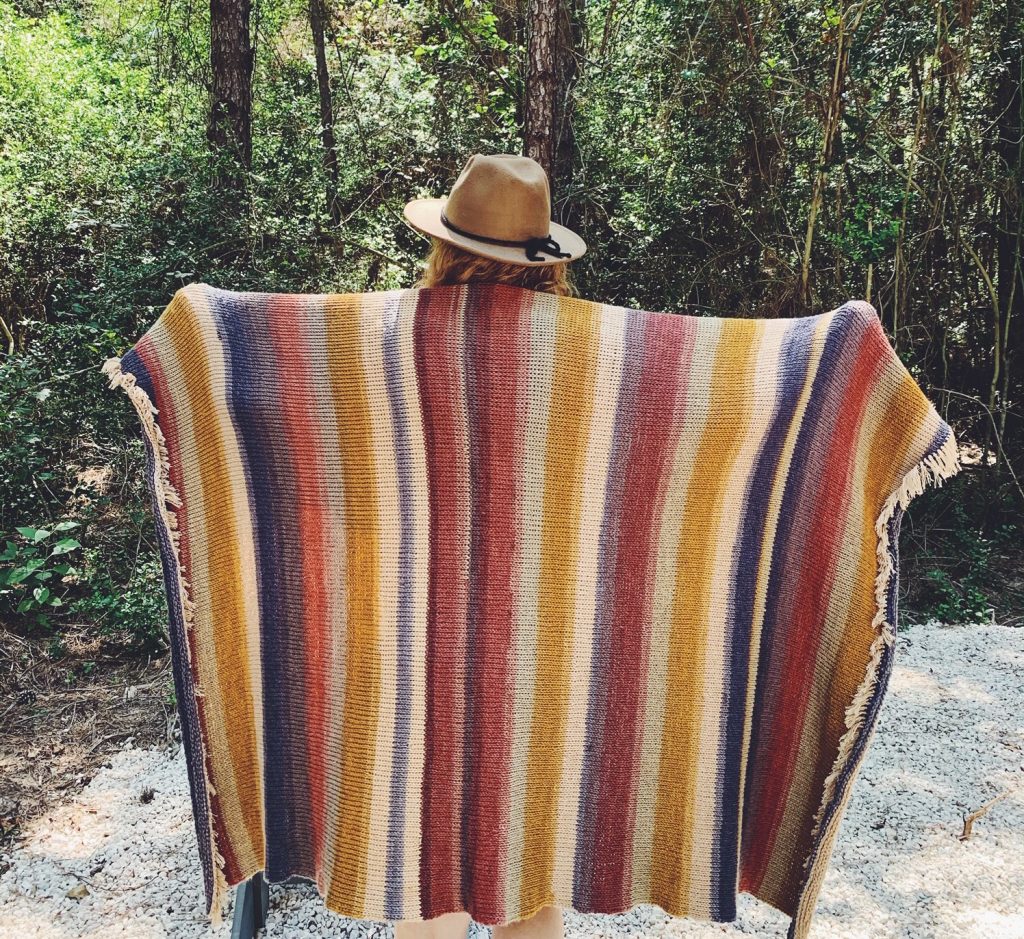
Learning the Tunisian knit stitch might seem hard at first, but it gets easier with practice. As a beginner, you might face some challenges. But don't worry, I'm here to help. I'll share common mistakes and tips to avoid them.
Maintaining Tension
Keeping your stitches even is a big part of Tunisian crochet. If your stitches are too loose, your work might look uneven. On the other hand, if they're too tight, your fabric could be stiff. It's all about finding the right balance.
Try to hold the yarn in a way that feels natural. Pay attention to how your tension changes as you work. This will help you get it just right.
Mastering the Tunisian Hook
The Tunisian crochet hook is different from regular crochet hooks. It might initially feel awkward, but you'll get used to it. Experiment with different grip techniques to find what works for you.
The more you practice, the more comfortable you'll become with the Tunisian hook. So, keep practicing those beginner stitches.
You'll soon be a pro at Tunisian crochet by tackling these common challenges and following my tips. With patience and practice, you'll make beautiful, cozy projects.
Let's start with your first project - A Tunisian Crochet Knit Stitch Blanket Pattern!
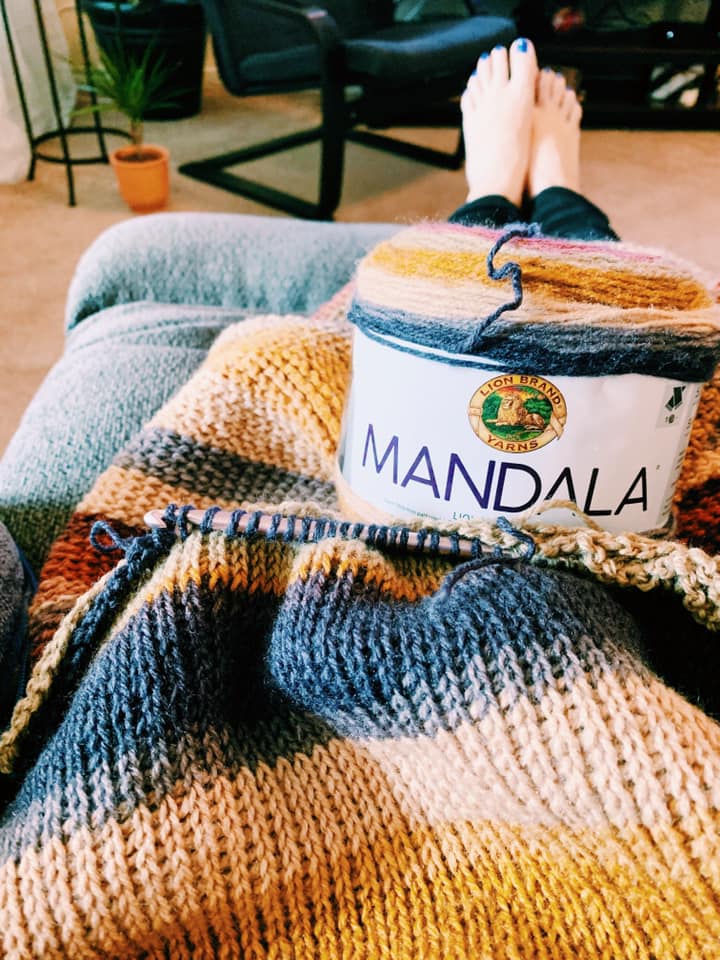
Tunisian Knit Stitch Crochet Blanket - The Let's Go Camping Blanket
You can purchase a printable PDF of this pattern on our ICCT shop here or Etsy here.
Creating a Tunisian knit stitch crochet blanket is a great way to learn this technique. It lets you make a soft, textured throw that adds warmth and style to your home.
The Tunisian knit stitch crochet blanket is ideal for snuggling up on cold nights by the campfire or adding a cozy touch to your living room.
Learning this technique will help you not only make a beautiful piece but also appreciate the art of Tunisian crochet more.
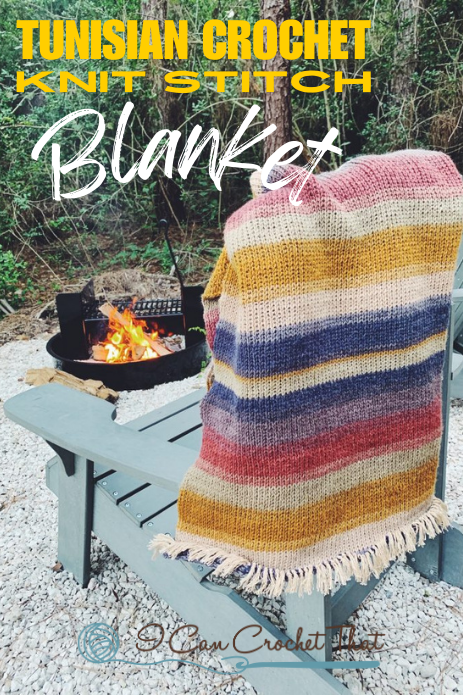
Choosing the Perfect Yarn and Colors
As I mentioned, one of my favorite yarns for Tunisian crochet is Lion Brand's Mandala yarn. It's self-striping and comes in so many gorgeous colorways.
Here are a few of them.
Yarn Weight and Fiber Considerations
When picking yarn for your Tunisian crochet, consider its weight and what it's made of. Like worsted or DK, light yarns create a soft, drapey fabric that's great for snuggling. Thicker yarns give your project a cozy, textured look.
The type of fiber also changes how your blanket looks and lasts. Natural fibers like wool or alpaca make it feel luxurious. Synthetic fibers like acrylic or polyester are easy to care for and come in bright colors.
Playing with different yarn weights and fibers can make your Tunisian crochet stand out.
When you become more experienced with Tunisian crochet, you can try mixing different-weight yarns to find the perfect match for your style and the look you want for your project.
We have several Tunisian crochet blanket patterns that call for different weights, such as The Ethan and The Bryn.
The "Let's Go Camping" Blanket Pattern
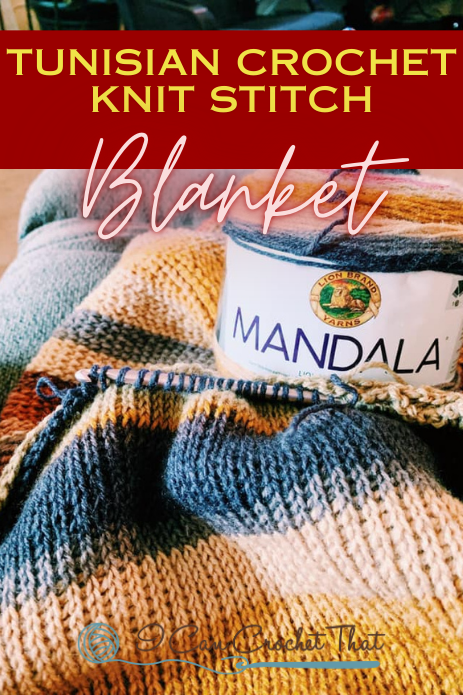
You can find more info on this pattern here, but here are the basics you need to know in order to make your own.
Pattern Notes
Details
Method Tunisian Crochet
Skill Level Beginner
Hook 6.0 mm / US 10 – Tunisian hook with cable
Other Yarn Needle
Yarn
Lion Brand Coboo in Beige (for the fringe)
(Purchase Coboo at LionBrand.com here or Amazon.com here)
Lion Brand Mandala in Centaur, 4 cakes 590 yards each, total of 2,360 yards
(Purchase Mandala yarn at LionBrand.com here or Amazon.com here)
Gauge 4” x 4” = 16 sts x 24 rows
Final Size 40″ wide x 57″ long (without fringe)
Abbreviations
Bump – strand of yarn on underside of chain
FwP forward pass
RetP return pass
st(s) stitch(es)
Tks Tunisian knit stitch
Tslst Tunisian slip stitch – for binding off
The Pattern
Rows include Forward Pass and Return Pass.
Foundation Row
FwP: Chain 152. Draw up a loop in back bump of second chain and in each chain across. (152 loops on hook)
RetP 152 sts
Row 1
Tks across (152 loops on hook)
RetP 152 stitches
Rows 2 – and on
Repeat Row 1 until blanket measures 57″ long or until it’s the size you want
Last row
Tslst Tunisian slip stitch across, fasten off, weave in all ends
For fringe
Cut 4 inch long strips of Coboo yarn and tie on both ends, you’ll need 304 pieces
After you’ve tied on the fringe pieces, comb through sections with small comb

Customizing Your Crochet Blanket
Creating your own Tunisian crochet blanket lets you add your special touch. Have a look at one of the colorways a customer chose for her camping blanket. It's gorgeous!
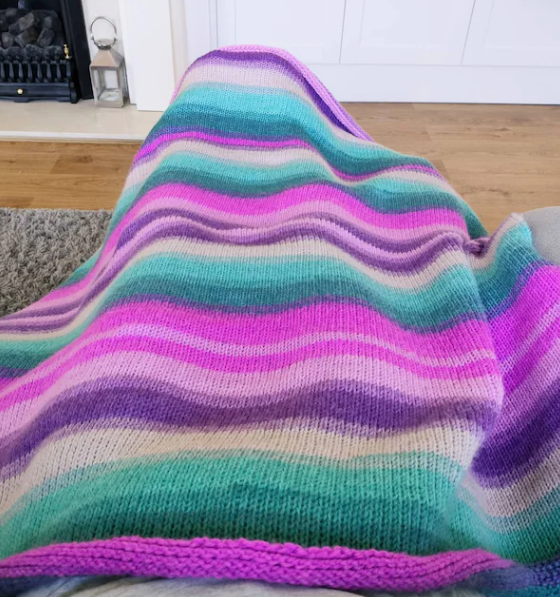
Finishing Touches and Edging Options
As your Tunisian knit stitch crochet blanket grows, consider the finishing touches. These can make your blanket look professional and cozy. You can choose from simple borders to intricate lace patterns for a polished look.
You can change up the border by adding tassels instead of fringe or crochet a border all the way around, similar to our Quinn blanket. It's easy to make your project truly unique.
This border on our Ophelia pattern is another great choice for these projects. It's neat and clean, making your blanket look classic.
Choosing a border is important, so take your time and pay attention to the details. With these techniques, your Tunisian knit stitch crochet blanket will look professional and beautiful.
Once you're finished, you'll be proud to display it at home or give it as a gift.
Conclusion
As we end our journey into the world of Tunisian crochet, I hope you now appreciate this craft more. Whether you're experienced or just starting, the skills you've learned can lead to endless creativity and projects.
The Tunisian knit stitch is both versatile and eye-catching. It lets you make cozy, personalized crochet blankets. This guide has given you the skills and confidence to start your Tunisian crochet project.
Starting your Tunisian crochet journey means facing challenges and enjoying the craft.
When I first learned Tunisian crochet, I almost gave up! But I stuck at it, and with enough practice, something finally clicked for me.
The Tunisian knit stitch might be tricky at first, but the feeling of finishing your first blanket is priceless.
So, take your Tunisian knit stitch crochet blanket on your next camping trip. Enjoy the warmth and personal touch it adds to your adventures.
FAQ
What is Tunisian Crochet?
Tunisian knit stitch is a special crochet method. It blends knitting's look and crochet's flexibility. The knit stitch makes a thick, textured fabric. It's great for making cozy blankets, scarves, and warm accessories.
What materials do I need to get started with Tunisian Crochet?
You'll need a Tunisian crochet hook with a long cable, yarn, scissors, and a tapestry needle. Choose the yarn's weight and fiber you like best, or follow our recommendations in the pattern.
How do I create the foundation row for Tunisian knit stitch?
Start by chaining the number of stitches you want. Then, do forward and return passes to set up the Tunisian stitch pattern.
What are some common mistakes to watch out for when learning Tunisian knit stitch?
Beginners often struggle with even tension, handling the Tunisian hook, and keeping the stitch count right. To avoid these issues, focus on your tension and follow the pattern closely.
How do I choose the right yarn for my Tunisian knit stitch crochet blanket?
Pick a yarn that matches the pattern recommendations. Bulky or worsted weight yarns are great for a cozy, textured blanket. Think about the yarn's fiber and color too.
Can I customize my Tunisian knit stitch crochet blanket?
Yes! Tunisian crochet lets you personalize your projects. You can use special stitches, mix colors, or add unique designs. This makes your blanket truly special.
What are some finishing techniques for a Tunisian knit stitch crochet blanket?
Finish your blanket with different edgings like simple borders, tassels or fringe. These touches can make your handmade blanket look even better.
We can't wait to see your finished projects! Be sure to tag us on socials @ICanCrochetThat so we can take a look and share your creations with our audience.
Would you like some more support from a community of people who love Tunisian crochet and others who are learning to love it? Join our private Facebook group. It's a fantastic group of people who love to help and share their creations.



